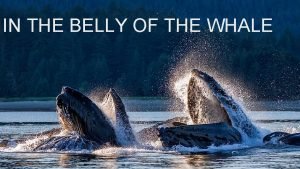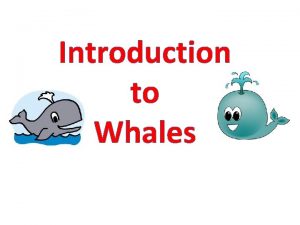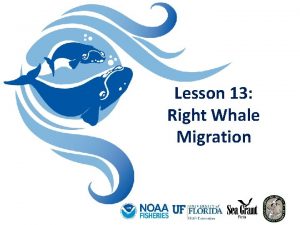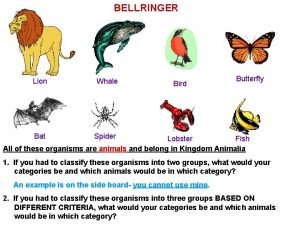Gray Whale Migration Whale Watching Physical Characteristics S









- Slides: 9

Gray Whale Migration & Whale Watching

Physical Characteristics S Adult females are slightly larger than males and measure ~50 feet long. S S Both sexes weigh 30 -40 tons. S Adult males measure 45 -46 feet in length. S The largest gray whales have flukes, or tails, that may span 10 feet. S Gray whales are gray with white patches. A 45 -foot, 35 -ton gray whale is about the same size as 10 large elephants.

Gray Whale Facts S The white patches mainly consist of barnacles and whale lice, which are attached to their skin. S On average, a whale carries over 400 pounds of barnacles on its body. S Whales rely on a layer of blubber up to 12 inches thick to help them maintain their body temperature. S Whales are voluntary breathers, which means they have to remember to breathe. This makes sleeping difficult. S Gray whales live to be 50 -60 years old. http: //www. biosbcc. net/ocean/marinesci/05 nekton/GWsouth. htm

Gray Whales’ Food Source S Except for babies, gray whales eat little or nothing during migration and in the lagoons of Mexico. S When they get home to their arctic feeding grounds, which are ice-free during the summer, they feast for 130140 days before heading south again. S It takes over 600 pounds of tiny krill (amphipods) and mysis shrimp to fill a gray’s stomach. S Gray whales have 2 -4 throat grooves about 5 feet in length. S These grooves expand during feeding, which requires a large intake of water and mud. S Gray whales feed on the bottom of the ocean floor, sifting through the mud with their baleen. http: //www. pbs. org/kqed/oceanadventures/educators/library

What is a Baleen Whale? S Gray whales don’t have teeth; they have baleen. S Baleen is made of plates of keratin, a fingernail-like material that frays out into fine hairs. S Baleen hangs on either side of the jaw, where teeth might otherwise be located. S The plates are off-white and are 2 -10 inches in length. S The whales feed on the right side of their mouths, and sediment is strained by the baleen to catch crustaceans. S The crustaceans are trapped in the baleen, which the whale licks with its tongue to dislodge and eat them. http: //www. biosbcc. net/ocean/marinesci/05 nekton/GWmigration. htm http: //www. sfgate. com/getoutside/photos/dec 97/baleen. gif

Gray Whale Habitat S They are found only in the Pacific Ocean. S Along the coastline, they have a population of ~26, 000. Around Korea and Japan, a small group of 100 -250 whales is on the brink of extinction. S Gray whales became extinct in the North Atlantic Ocean in the 17 th century due to hunting. S The whales’ habitat ranges from the Arctic Ocean northwest of Alaska to the Baja peninsula in Mexico. http: //www. biosbcc. net/ocean/marinesci/05 nekton/GWmigration. htm

Gray Whale Behaviors S The whales migrate to give birth and mate in a warm climate. S They migrate along the coastline and are the only whale that eats from the ocean floor. S Gray whales form small pods from 3 -16 members. S Spy-hopping is a gray whale behavior where the whale pokes its head up to 10 feet out of the water to look around. S Gray whales also breach, or jump partially out of the water, causing a loud noise when they land. S This may be a form of communication, as are their various grunts, clicks, and whistles. http: //www. pbs. org/kqed/oceanadventures/educators/library

Baby Whale S The baby whale weighs 1, 100 -1, 500 lbs. and is ~15 feet long at birth. S The warmer waters of Baja Mexico’s shallow lagoons help newborns conserve body heat. S S They are born lean and without blubber. S The milk contains 53% fat, and calves may gain 60 -70 pounds daily, building up blubber for their cold trip north. S Female whales help each other at birth. The “Auntie” pushes the newborn calf up to the surface to ensure it does not drown. The calves nurse for about 6 months, during which time the mother provides up to 50 gallons of milk each day.

Whale Nurseries S Gray whales migrate farther than any mammal on Earth. S Each year they swim from the cold Arctic to warm Mexican lagoons and back again, traveling over 10, 000 miles. S They leave the cold waters of the Bering Sea in November and swim for 55 days nonstop. S In January they arrive in the warm, safe lagoons of Mexico’s Baja Peninsula, just in time to give birth. S The whales remain in the lagoons for 3 months and start their return trip to the Bering Sea in March. http: //www. pbs. org/kqed/oceanadventures/educators/library/
 Watching lecture than watching it at
Watching lecture than watching it at A whale watching company noticed that many customers
A whale watching company noticed that many customers Baleen whale vs toothed whale
Baleen whale vs toothed whale Mammals characteristics
Mammals characteristics Physical and non-physical rate fences
Physical and non-physical rate fences What is physical fitness test in mapeh
What is physical fitness test in mapeh Their eyes were watching god chapter 19-20 summary
Their eyes were watching god chapter 19-20 summary Their eyes were watching god chapter summary
Their eyes were watching god chapter summary Their eyes were watching god summary
Their eyes were watching god summary Starched and ironed her face
Starched and ironed her face

















